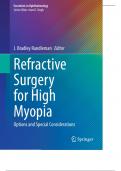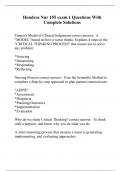Essentials in Ophthalmology
Series Editor: Arun D. Singh
J. Bradley Randleman Editor
Refractive
Surgery
for High
Myopia
Options and Special Considerations
,Essentials in Ophthalmology
Series Editor
Arun D. Singh, Cleveland Clinic Foundation, Cole Eye Institute,
Cleveland, OH, USA
,Essentials in Ophthalmology aims to promote the rapid and efficient transfer
of medical research into clinical practice. It is published in four volumes per
year. Covering new developments and innovations in all fields of clinical
ophthalmology, it provides the clinician with a review and summary of recent
research and its implications for clinical practice. Each volume is focused on
a clinically relevant topic and explains how research results impact diagnostics,
treatment options and procedures as well as patient management.
The reader-friendly volumes are highly structured with core messages,
summaries, tables, diagrams and illustrations and are written by internationally
well-known experts in the field. A volume editor supervises the authors in
his/her field of expertise in order to ensure that each volume provides cutting-
edge information most relevant and useful for clinical ophthalmologists.
Contributions to the series are peer reviewed by an editorial board.
,J. Bradley Randleman
Editor
Refractive Surgery
for High Myopia
Options and Special Considerations
,Editor
J. Bradley Randleman
Cole Eye Institute
Cleveland Clinic Lerner College of Medic
Cleveland, OH, USA
ISSN 1612-3212 ISSN 2196-890X (electronic)
Essentials in Ophthalmology
ISBN 978-3-031-40559-4 ISBN 978-3-031-40560-0 (eBook)
https://doi.org/10.1007/978-3-031-40560-0
© The Editor(s) (if applicable) and The Author(s), under exclusive license to Springer Nature
Switzerland AG 2023
This work is subject to copyright. All rights are solely and exclusively licensed by the Publisher,
whether the whole or part of the material is concerned, specifically the rights of translation,
reprinting, reuse of illustrations, recitation, broadcasting, reproduction on microfilms or in any
other physical way, and transmission or information storage and retrieval, electronic adaptation,
computer software, or by similar or dissimilar methodology now known or hereafter developed.
The use of general descriptive names, registered names, trademarks, service marks, etc. in this
publication does not imply, even in the absence of a specific statement, that such names are
exempt from the relevant protective laws and regulations and therefore free for general use.
The publisher, the authors, and the editors are safe to assume that the advice and information in
this book are believed to be true and accurate at the date of publication. Neither the publisher nor
the authors or the editors give a warranty, expressed or implied, with respect to the material
contained herein or for any errors or omissions that may have been made. The publisher remains
neutral with regard to jurisdictional claims in published maps and institutional affiliations.
This Springer imprint is published by the registered company Springer Nature Switzerland AG
The registered company address is: Gewerbestrasse 11, 6330 Cham, Switzerland
Paper in this product is recyclable.
,To the newest additions to my writing team, my beautiful twins
Evan and Julia. May this be one of many adventures we share
together!
,Preface
A myopic epidemic is overtaking the globe, with dramatically increasing
prevalence of myopia in general and high myopia in particular [1−3].
Regardless of the ultimate success of preventive measures, a significant por-
tion of the world’s current population will reach adulthood with significant
myopic refractive error. Fortunately, refractive surgery has seen tremendous
progress in safety, efficacy, and treatment options over the last two decades.
LASIK and photorefractive keratectomy (PRK) remain safe and effective
options for the correction of high myopic refractive errors, while newer pro-
cedures including small incision lenticule extraction (SMILE), phakic intra-
ocular lenses, and refractive lens exchange with new IOL technology have
vastly expanded the spectrum of effective treatment options available.
In the past decade alone, lenticule extraction approvals have expanded to
treat high myopia with astigmatism, toric varieties of phakic intraocular
lenses are now available, and a variety of presbyopia-correcting IOL tech-
nologies exist in both toric and non-toric models. Corneal cross-linking
(CXL) has also become available worldwide and is evaluated as an adjunct
procedure to stabilize corneas undergoing highly myopic corrections. Thus,
the majority of highly myopia patients today can be treated with one or mul-
tiple effective procedures.
The correction of high myopia is uniquely challenging, however, because
significant safety concerns remain, and given the expanded treatment options
there is frequently confusion regarding the best strategy for individual
patients. There is thus a need for enhanced patient screening necessary to best
match procedure with risk/benefit profile in this unique population.
This book will endeavor to focus on the unique aspects of refracted surgi-
cal correction for high myopia to assist the reader in choosing the best proce-
dures for each individual. Chapter 1 defines and details the problem facing
our populations worldwide. Chapter 2 covers the basic tenets for refractive
surgery screening and highlights the unique aspects critical for appropriate
evaluation of the highly myopic patient. Chapters 3 through 7 discuss each
available procedure in detail, including LASIK (Chap. 3), photorefractive
keratectomy (Chap. 4), SMILE (Chapter 5), phakic IOLs (Chap. 6), and
refractive lens exchange (Chap. 7). In Chap. 8, future considerations for the
correction of high myopia are discussed, and in the final chapter the authors
go through a series of real cases and discuss their thoughts, approaches, and
treatment strategies, including when not to offer surgery.
vii
,viii Preface
Refractive surgery has come of age across a wide spectrum of refractive
disorders and, with appropriate patient screening, presents a reasonable first-
line solution to the growing problem of refractive errors in general and high
myopia in particular. When considering all factors, refractive surgery may be
the optimal option for the correction of refractive error in many instances [4,
5]. We hope you find this book enlightening on how to address the needs of
your highly myopic patients most safely and efficaciously.
References
1. Holden BA, Fricke TR, Wilson DA, Jong M, Naidoo KS, Sankaridurg P,
et al. Global Prevalence of Myopia and High Myopia and Temporal Trends
from 2000 through 2050. Ophthalmology. 2016;123(5):1036-42.
2. Vitale S, Ellwein L, Cotch MF, Ferris FL, III, Sperduto R. Prevalence of
Refractive Error in the United States, 1999-2004. Archives of
Ophthalmology. 2008;126(8):1111-9.
3. Li Y, Liu J, Qi P. The increasing prevalence of myopia in junior high
school students in the Haidian District of Beijing, China: a 10-year popu-
lation-based survey. BMC Ophthalmol. 2017;17(1):88.
4. Alió JL, Krueger RR, Bidgoli S. The World Burden of Refractive
Blindness. J Refract Surg. 2016 Aug 1;32(9):582-4.
5. Reinstein DZ. The Time Has Come for Refractive Surgery to Be Included
in the Fight Against Global Visual Impairment Due to Uncorrected
Refractive Error. J Refract Surg. 2022 Jan;38(1):6-8.
Cleveland, OH, USA� J. Bradley Randleman
,Contents
1 ��
Epidemiology of High Myopia����������������������������������������������������������� 1
Ilyse D. Haberman
2 ��Preoperative Evaluation for Refractive Surgery
in Patients with High Myopia ����������������������������������������������������������� 9
Lara Asroui and J. Bradley Randleman
3 ��
LASIK for High Myopia��������������������������������������������������������������������� 23
Gabriel S. Valerio and Edward E. Manche
4 ��
PRK for High Myopia������������������������������������������������������������������������� 31
Marcony R. Santhiago and Lycia Pedral Sampaio
5 ��
SMILE for High Myopia ������������������������������������������������������������������� 39
E. N. Wong and Jodhbir S. Mehta
6 ��Phakic Intraocular Lens (pIOL) in the Treatment
of High Myopia����������������������������������������������������������������������������������� 57
Majid Moshirfar, Amir Ali, Carter Payne,
and Courtney Webster
7 ��
Refractive Lens Exchange in High Myopia ������������������������������������� 77
Julie M. Schallhorn
8 ��
Future Directions for High Myopia Correction������������������������������� 83
Sheetal Brar and Sri Ganesh
9 ��
Refractive Surgery for High Myopia: Case Section������������������������� 89
J. Bradley Randleman and Imane Tarib
��Index����������������������������������������������������������������������������������������������������������� 121
ix
, Epidemiology of High Myopia
1
Ilyse D. Haberman
�Definition of Myopia as many as 90% in a population of East Asian
school students [2, 3]. It is estimated that in the
Myopia is a refractive error within the eye that year 2000, there were 1.4 billion myopes (22.9%
causes light to focus in front of the retina. This is global prevalence) and 163 million people (2.7%
usually caused by an increase in axial length, but global prevalence) with high myopia.
also can be from increased corneal curvature or Extrapolating current trends, by 2050 it is
increased refractive power of the crystalline lens. expected that 50% of the world’s population will
The standard for measurement of refractive error be myopic, for a total of around 5 billion people.
is via cycloplegic refraction, especially in It is predicted that about 938 million people will
children. have high myopia, or about 9.8% of the world’s
The World Health Organization defines myo- population [2]. Figures 1.1 and 1.2 depict the
pia as refractive error less than or equal to −0.50D relative proportion of refractive errors in the
and high myopia as less than or equal to −5D. The United States in 1999–2004, demonstrating the
International Myopia Institute, and most pub- higher prevalence of myopia and high myopia
lished studies, define high myopia as a refraction among 20–39 year olds compared to those over
of −6D or more [1]. When interpreting preva- 60 years [4].
lence rates in individual studies, it is important to The prevalence of myopia in school children
note the refraction threshold for defining high has been studied and has demonstrated wide
myopia as well as whether the subjects were ranges across nations. Less developed nations
cyclopleged during refraction. often have a prevalence of less than 10% [5–7].
East Asia (including Singapore, urban areas of
China, South Korea, and Taiwan) has the highest
� revalence of Myopia and High
P prevalence of myopia, reporting rates of any-
Myopia where from 29.5% to 90% of school-aged chil-
dren [8–12]. France had a prevalence of 39.1% in
The prevalence of myopia varies across different 2013–2014 [13], and the United States similarly
regions of the world. Currently, 30–50% of had a rate of 34.5% in 2010 [2].
American adults are myopic, and the rate rises to
I. D. Haberman (*)
Department of Ophthalmology, NYU Langone
Health, New York, NY, USA
e-mail: Ilyse.haberman@nyulangone.org
© The Author(s), under exclusive license to Springer Nature Switzerland AG 2023 1
J. B. Randleman (ed.), Refractive Surgery for High Myopia, Essentials in Ophthalmology,
https://doi.org/10.1007/978-3-031-40560-0_1





